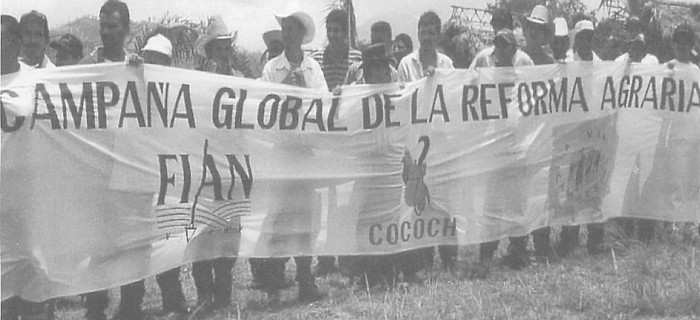Tides Shift on Agrarian Reform: New Movements Show the Way
Food First Backgrounder, Winter 2001, Vol. 7, No. 1
Only rarely are we privileged to bear personal witness at historical turning points that symbolize and crystallize a changing of the tides. For decades the very phrase ‘Central America’ conjured up images of poverty, destitution, and the most hideous military repression; of dirty wars, the CLA, genocide, torture, and growing landlessness in dirt poor rural areas. The end of the armed struggles of the 1980s meant an end to war, but also, ironically, to short-term prospects of installing radical pro-poor governments—the end of a certain kind of hope. Yet in Central America at the dawn of the new millennium, and indeed across most of the Third World, we are seeing the emergence of a new source of hope, of new dreams—those of the largely non-violent poor people’s movements who sidestep government inaction and take matters firmly into their own hands.
In Honduras, home to many dynamic organizations of landless peasants struggling for land, I witnessed a moment that signifies a turning of the tides of landlessness. On July 26, 2000, I was one of fifty visitors from 24 countries in Asia, Africa, Europe, and the Americas to visit the 5000 hectare site of the former Regional Center for Military Training (CREM) in Colon, Honduras. During the 1980s the notorious CREM was used by the US military to train the Salvadoran, Guatemalan, and Honduran militaries in counter-insurgency, and the Nicaraguan contras in counter-revolution. Here was where some of the world’s worst violators of human rights learned their craft on the US taxpayers’ tab. The CREM was reportedly the site of a secret prison for ‘disappeared’ activists from Central America, and contains a recently discovered clandestine mass grave where some of those political prisoners presumably ended up—and for which five former military officers, including former Honduran vice president General Walter Lopez, were charged in 1998.
With the end of the Cold War, this killing field was vacated by the US and Honduran armies, and in 1991 the Honduran Congress voted to make it available for distribution to landless peasants, whose numbers swelled over years of economic crisis and land grabs by the wealthy. The property transfer never happened, as titles to the land mysteriously appeared in the hands of military officers, politicians, and landlords—titles the government refused to annul despite multiple protests and legal challenges by peasant organizations.
Access to land is a fundamental human right for rural peoples, and grossly inequitable distribution of land is one the most common underlying causes of poverty and destitution in much of the world.
In early 2000 the landless members of the Peasant Movement of Aguán decided to take matters into their own hands. Some 900 families—more than 4000 men, women, and children—occupied the land and immediately planted crops, built ramshackle homes of cardboard, tin, palm leaves, and scavenged wood, and erected a modest schoolhouse, community center, and communal kitchen. They came into immediate conflict with the hired thugs of the landlords: one of their leaders was killed, and they had to organize nightly self-defense patrols to ward off snipers who would fire pot shots into the makeshift community under the cover of darkness. The peasants declared they would never be dragged off the land alive. When you have no land, you have nothing. With land, you have something to live for, and, paradoxically, something to die for.


 Help Food First to continue growing an informed, transformative, and flourishing food movement.
Help Food First to continue growing an informed, transformative, and flourishing food movement.




